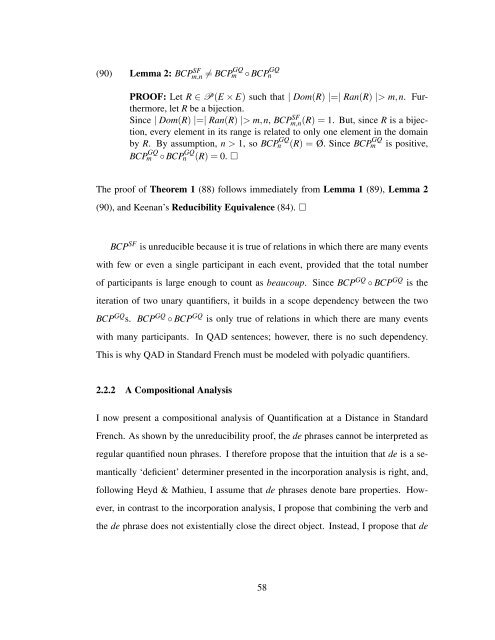Formal Approaches to Semantic Microvariation: Adverbial ...
Formal Approaches to Semantic Microvariation: Adverbial ...
Formal Approaches to Semantic Microvariation: Adverbial ...
Create successful ePaper yourself
Turn your PDF publications into a flip-book with our unique Google optimized e-Paper software.
(90) Lemma 2: BCPm,n SF ≠ BCPm<br />
GQ<br />
◦ BCP GQ<br />
n<br />
PROOF: Let R ∈ P(E × E) such that | Dom(R) |=| Ran(R) |> m,n. Furthermore,<br />
let R be a bijection.<br />
Since | Dom(R) |=| Ran(R) |> m,n, BCPm,n(R) SF = 1. But, since R is a bijection,<br />
every element in its range is related <strong>to</strong> only one element in the domain<br />
by R. By assumption, n > 1, so BCPn<br />
GQ (R) = Ø. Since BCPm<br />
GQ is positive,<br />
BCPm<br />
GQ ◦ BCPn<br />
GQ (R) = 0. □<br />
The proof of Theorem 1 (88) follows immediately from Lemma 1 (89), Lemma 2<br />
(90), and Keenan’s Reducibility Equivalence (84). □<br />
BCP SF is unreducible because it is true of relations in which there are many events<br />
with few or even a single participant in each event, provided that the <strong>to</strong>tal number<br />
of participants is large enough <strong>to</strong> count as beaucoup. Since BCP GQ ◦ BCP GQ is the<br />
iteration of two unary quantifiers, it builds in a scope dependency between the two<br />
BCP GQ s. BCP GQ ◦ BCP GQ is only true of relations in which there are many events<br />
with many participants. In QAD sentences; however, there is no such dependency.<br />
This is why QAD in Standard French must be modeled with polyadic quantifiers.<br />
2.2.2 A Compositional Analysis<br />
I now present a compositional analysis of Quantification at a Distance in Standard<br />
French. As shown by the unreducibility proof, the de phrases cannot be interpreted as<br />
regular quantified noun phrases. I therefore propose that the intuition that de is a semantically<br />
‘deficient’ determiner presented in the incorporation analysis is right, and,<br />
following Heyd & Mathieu, I assume that de phrases denote bare properties. However,<br />
in contrast <strong>to</strong> the incorporation analysis, I propose that combining the verb and<br />
the de phrase does not existentially close the direct object. Instead, I propose that de<br />
58
















